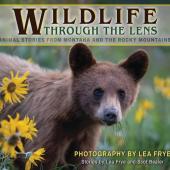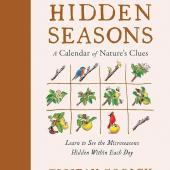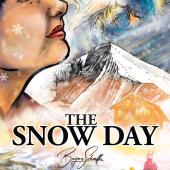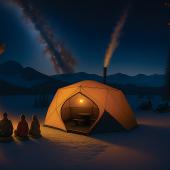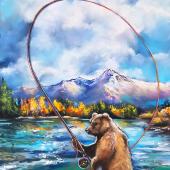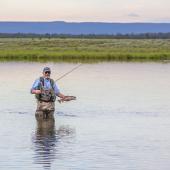Wordsmiths of SW Montana: Tim Cahill
Author of eight travel books and over 300 articles, Tim Cahill has earned his reputation as America’s best-loved adventure journalist. He has held us captive with dangerous exploits and made us laugh with his sly, self-deprecating humor for 25 years. He insists it is not a penchant for danger that lured him to the salt mines in the Sahara Desert or to the jungles of Colombia to interview guerrilla fighters, but rather the need to provide honest reporting to his readers. In a recent effort, Lost in My Own Backyard, an insider’s guide to Yellowstone Park, he turned his focus closer to home. Tim moved to Livingston long before it became a haven for the literati of the Northwest, because it has the amenities he needs: rivers, mountains, and unending beauty.
When his father, who ran a coal yard in a small Wisconsin town, told him that the happiest people he knew made their hobby their business, Tim dared to reveal his secret desire to be a writer. He ventured to San Francisco in the early 70’s and landed a job at Rolling Stone. From there he became a founding editor of Outside. He convinced his colleagues that if he applied fictional writing techniques to articles about outdoor adventures, there would be a hungry audience. This innovation brought instant success to the magazine and gave him a lifetime of all-expenses-paid adventure.
O/B: How does living in Montana influence your writing?
TC: The small town I live in gives me a strong base. I have many friends, none of whom are too damn impressed by what it is I do for a living. “You can’t fire a cannon from a canoe.” Which means—your base has to be solid. This little town is my solid base.
What are your main hobbies/avocations?
Outdoor sports—kayaking, backpacking, caving, river running—and long fast trail walks with my dogs, during which I get a lot of thinking done. The daily trail walks might even be considered a part of my “process.”
Tell me more about your daily writing regime?
I get up, eat breakfast, and try to be at my desk within 30 minutes. I do three to four hours of “blank-page writing.” The rest of the work day is consumed with polishing, research, fact checking, and rewriting.
In general, which do you prefer as a means of communication from the outside world: TV, newspapers, or the internet?
I use them all, and also listen to the radio. I do an awful lot of research on the ‘net these days.
What do you consider your best piece of work and your worst piece of work?
My best work is the last thing I finished. My worst is the first thing I published. All writers have to feel that way. To say otherwise is a clear admission that we are not getting better at our jobs.
What is the biggest challenge in your writing career?
Writing well. (Geez, you asked.)
What responsibilities do you feel you have to your readers?
Factual accuracy. Entertainment. The production of emotion. Education, obliquely delivered.
Were you a bookworm as a kid?
I was a late reader, but after reading my first real book I was hooked and read voraciously, piling through genres. I even read classical literature. For fun. I also liked history, particularly ancient history, and majored in this subject in college.
Do you agree that you created a new genre that combines journalism, storytelling, and travel writing into one very entertaining package?
Not really. I was one of four editors at Outside. We looked at every outdoor magazine that was around in 1975-1976 and found they were mostly service-oriented. They told you how to paddle a canoe. The pundits made fun of us because it’s a well-known fact that people who read don’t go outdoors. I didn’t have an education in journalism.
No, but you had a degree in creative writing from the University of San Francisco.
Right. So, I simply used the fiction storytelling tools that I have and applied them to nonfiction. So, did I personally create this genre? Yep. Sure. Nobody else could have done it. (Laughs) Although, if you look you will see that I was greatly inspired by Edward Abbey and a book called Desert Solitaire and especially a story called “Dead Man at Grand View Point.”
What’s one of your favorite words, and why?
“Conversational.” It is my style of writing. I hardly ever use the word in my writing or conversation. It’s not very conversational.
Were you always able to write the way you wanted?
Since nobody was doing the kind of work I was doing, I had to figure out how it was done. I did get friction from editors, but I’ve always been a fierce proponent of my own goddamned point of view. If my stories are identifiably Cahill stories, it is because I demand that they be that way.
How do you categorize your work? Are your pieces essays or articles?
What people label them does not matter to me. I want people to read them. I want to be able to influence them emotionally. I want to be able to make them laugh and to make them cry. I want to make them think about the same kinds of things that I am thinking about. Those are my goals. Whether you call it literary nonfiction or whether you call it journalism, it makes no difference to me.
What profession other than writing would like to participate in, and why?
Aside from writing, I imagine I’m unemployable.
Books by Tim Cahill
Not So Funny When It Happened: The Best of Travel Humor and Adventure (2006)
The Best American Travel Writing 2006 (editor; 2006)
Lost In My Own Backyard: A Walk in Yellowstone National Park (2004)
Hold the Enlightenment (2002)
Dolphins (2000)
Pass the Butterworms: Remote Journeys Oddly Rendered (1997)
Pecked to Death by Ducks (1993)
Road Fever: A High-Speed Travelogue (1991)
A Wolverine is Eating My Leg (1989)
Jaguars Ripped My Flesh (1987 and 1996)
Buried Dreams: Inside the Mind of a Serial Killer (1986)








